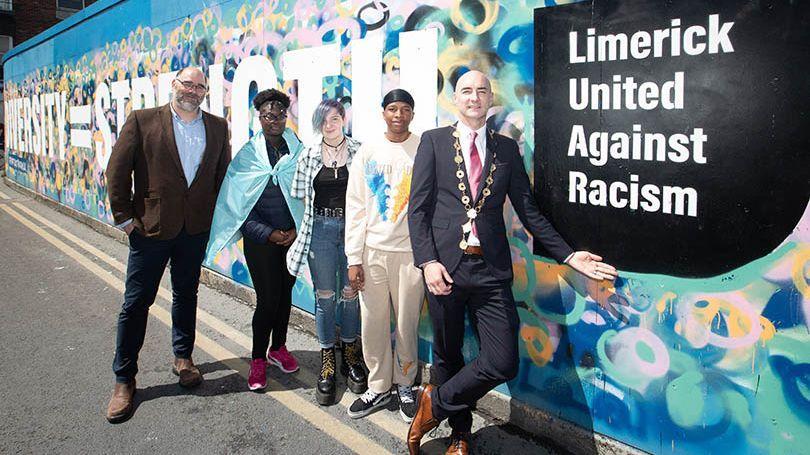In-migration of people from different cultural backgrounds is a new experience for Ireland. Up to the early 2000’s culturally, Ireland was a relatively homogenous society. Over generations – post the great famine (1845-1847) into the 1980’s and early 1990’s – Ireland experienced waves of emigration and loss of its young people. Irish emigrants went mainly to the English-speaking countries of the UK, USA, Canada and Australia. In the early waves and well into the 1950’s and 1960’s, Irish emigrants tended to lack education and skills but by the 1980’s, they included well-educated young people leaving Ireland to seek work abroad. This represented a big loss to the country’s economy and society and to communities and family life, particularly affecting rural areas.
Ireland’s experience of migration is influenced by its past and its pattern of economic development. Its colonial history is one of being colonised by the English and ruled within the British Empire for some 700 years until Ireland (excluding counties in Northern Ireland) became independent in 1922. Following membership of the EEC in 1973, Ireland accelerated its economic development from a mainly agricultural country lacking industrial development to what is now a successful economy, with a small and highly efficient agricultural sector, advanced manufacturing sectors, construction and a services economy. With the economic boom in the 2000’s, there was a surplus of jobs in Ireland. This coincided with expansion of the EU to include new Member States from the former eastern bloc countries of Europe, with most of those countries completing accession to the EU in 2004, and Bulgaria and Romania in 2007. As well as the significant increase in migrant workers and their families from new EU Member States – pulled by many job opportunities and relatively higher wages in Ireland – there was an increase in migration from non-EU countries. These included asylum seekers and refugees, migrant workers from outside of the EU as well as international students coming to study at Limerick’s third level colleges. In-migration has been strongly influenced by cycles of economic growth and recession in Ireland. The Great Recession following from the financial crisis (2008) and into 2013 stemmed the flow of migrants into Ireland looking for work while some returned to their home countries during these years.
Migrant Populations in Limerick
In 2006, Census data for Limerick City and County show 16,113 non-Irish nationals living in Limerick (8.9% of the population); by 2011, this was 25,763 non-Irish nationals (13.5% of the population). In the 2016 Census, the number of non-Irish nationals in Limerick was 18,476 (9.6%) of the population with an additional 3,239 persons having dual nationality (1.7% of the population of Limerick city and county). Indeed, based on Census 2016 data, there were over 40 nationalities living in Limerick at that time.
Since 2016, the population of Ireland and the numbers of migrant people to Ireland are growing. This is occurring with strong economic recovery and expansion post-Covid and new factors that are fuelling migration into the EU – wars, famines and human rights abuses in other part of the world. The specific numbers of people of different nationalities and cultural backgrounds currently living in Ireland and Limerick from Census 2022 are not yet available. On the first anniversary of the war in Ukraine, the number of refugees arriving in Ireland fleeing the war in Ukraine is approaching 73,000 (Central Statistics Office). Currently, 74,000 refugees and International Protection Applicants are in state-funded accommodation, of which 49,227 are Ukrainian refugees and 23,382 asylum seekers. In Limerick, there were 2,097 known Ukrainian nationals under Temporary Protection, processed through the International Protection Accommodation Services (IPAS), and an additional 347 are in pledged accommodation. In addition, there are 717 persons seeking asylum / under international protection accommodated in state-funded Direct Provision Centres. There are five in total located in or serviced by Limerick City. Combined, these figures represent a large increase in the population seeking protection in a very short period of time.
Currently, we find concentrations of migrant populations, including families with young children, in Limerick inner city and in our larger towns. With the shortage of accommodation, rural towns and villages are the location of buildings now being used to accommodate refugee populations in congregated settings – such as buildings that were formerly convents, schools and nursing homes and some hotel accommodation. This is expected to continue as more buildings are being sought to meet accommodation needs of newcomers.
Opening of the Templeglantine Guru Nanak Sacred Forest, attended by Limerick Mayor Francis Foley and Dr Jagdeep Singh from EcoSikh Ireland.
Changing Context: Pressures on Housing and Services
This new migration flow of people seeking international protection is happening at a time of population increase from natural increase and in-migration for other reasons. The level of population increase is putting additional pressures on public and social infrastructure and services. While the economy is strong and the labour market booming, there is a significant shortage of accommodation and a housing crisis in Ireland. This shortage is across all types of housing provision – social housing, affordable housing, private housing including house purchase and rental accommodation. Housing is an area of policy where ramping up supply has been slow to materialise. Hosting those seeking asylum in Direct Provision Centres is due to end in 2024, and is to be replaced by a new accommodation model and support services. This is an additional pressure in view of the existing lack of supply of accommodation.
Other pressure area are in access to health services and school places. Health / health services faces challenges in reform to create a structure and services based on universal provision. In these pressure area, change to improve the situation will happen slowly.
Access to services is more difficult for migrants under International Protection that are in accommodation in rural areas where the services (health, welfare, social services, psychological support, education) are not well developed. There are also few job opportunities in these areas. Public transport to areas where there are jobs and a greater range of services is lacking.
A Supportive Policy and Political Context for Migration
Ireland sees and presents itself as a welcoming nation, especially so taking into account its history of emigration. National policy and the political system support migration and promote a model based on integration, equality and inclusion within a wider culturally diverse society. Government and all political parties continue to confirm Ireland’s commitment to play its role in international protection.
However, with societal pressure points, shortages in housing and difficulties in access to essential public services, there are some fractures in evidence in terms of society-wide support for people with a migrant or refugee background. This, for instance, is reflected in local protests against arrivals of these communities into centres offering accommodation. Equally and more vocally, however, there are protests in local communities and in Irish cities, including Limerick, supportive of migration and anti-racism.
Mayor of the City and County of Limerick Cllr Daniel Butler with Eugene Quinn, Member of the Limerick Integration Working Group, Grace Ajibade, Asher O’Priosair and Genius Makhubela.




